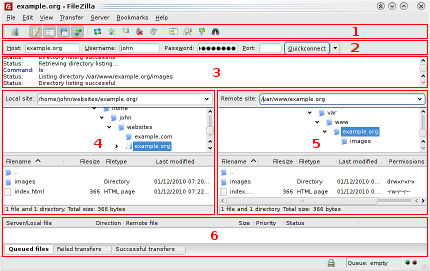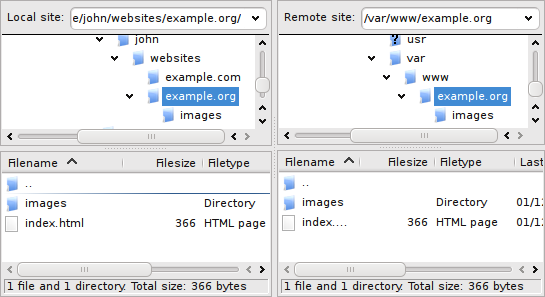FileZilla Client Tutorial (fa)
این آموزش به زبانهای دیگر: انگلیسی, آلمانی, اسپانیایی, فرانسوی
برای ویرایشگران: لطفا قبل از اضافه کردن هرگونه متن این موارد را مطالعه کنید.
معرفی
به آموزش کلاینت فایلزیلا خوش آمدید. در این آموزش، شما موارد زیر را یاد خواهید گرفت:
- نحوه اتصال به سرور FTP
- دانلود و آپلود فایلها
- استفاده از بخش مدیریت سایتها
اگر شما نحوه استفاده از کلاینت فایلزیلا را بلد بوده و نیاز به مطالعه موارد پیشرفتهتر دارید این بخش را مطالعه نمایید. پیشفرض ما این است که شما قبل از این آموزش کلاینت فایلزیلا را نصب کردهاید. ((آموزش نحوه نصب).
اتصال به سرور
اولین کار اتصال به سرور است و برای اتصال، اطلاعات زیر موردنیاز است که در اینجا از اطلاعات نمونه برای اعتبارسنجی استفاده شده و شما باید از اطلاعات سرور خود استفاده کنید:
Hostname: example.org Username: john Password: 7PjU#.J3
برای برقراری اتصال از بخش quickconnect استفاده خواهیم کرد:
فیلد Host را با مقدار hostname، فیلد Username را با مقدار Username و فیلد Password را با مقدار Password کامل کنید. شما میتوانید فیلد Port را خالی بگذارید مگر اینکه اطلاعات سرور شما شامل شماره پورت هم باشد. اکنون میتوانید روی گزینه Quickconnect کلیک کنید.
اگر اطلاعات ورود شما شامل پروتکلهایی مانند SFTP یا FTPS بود مقدار hostname را به شکل sftp://hostname یا ftps://hostname پر کنید.
اکنون فایلزیلا برای اتصال به سرور تلاش خواهد کرد. اگر تلاش موفقیت آمیز بود شما ستون سمت راست به جای گزینه Not connected to any server، فهرستی از فایلهای و فولدرها را مشاهده خواهید کرد.
ناوبری و لایههای مختلف

گام بعدی آشنایی با پنجرههای لایههای فایلزیلا خواهد بود.
Here is a quick introduction: Below the toolbar (1) and quick connect bar (2), the message log (3) displays transfer and connection related messages. Below, you can find the file listings. The left column (local pane, 4) displays the local files and directories, i.e. the stuff on the PC you're using FileZilla on. The right column (server pane, 5) displays the files and directories on the server you are connected to. Both columns have a directory tree at the top and a detailed listing of the currently selected directory's contents at the bottom. You can easily navigate either of the trees and lists by clicking around like in any other file manager. At the bottom of the window, the transfer queue (6) lists the to-be-transferred and already transferred files.
انتقال فایلها
Now we will upload these files (or the ones you choose, respectively):
website/
+- index.html
+- images/
+- image01.jpg
+- image02.jpg
Uploading
First - in the local pane - bring the directory into view which contains data to be uploaded (e.g. index.html and images/). Now, navigate to the desired target directory on the server (using the server pane's file listings). To upload the data, select the respective files/directories and drag them from the local to the remote pane. You will notice that the files will be added to the transfer queue at the bottom of the window and soon thereafter get removed again - since they were (hopefully, if nothing went wrong) just uploaded to the server. The uploaded files and directories should now be displayed in the server content listing at the right side of the window.
Note: If you don't like using drag-and-drop, you can also right click on files/directories (in the lower local pane) and select Upload to upload them - or simply double-click a file entry (this does not work for directories).
Note (advanced): If you enable filtering and upload a complete directory, only the not-filtered-out files and directories inside this directory will be transferred.
Downloading
Downloading files, or complete directories, works essentially the same way as uploading - you just drag the files/directories from the remote pane to the local pane this time, instead of the other way round.
Note: In case you (accidentally) try to overwrite a file during upload or download, FileZilla will by default display a dialog asking what to do (overwrite, rename, skip...).
Using the site manager
Now that you are confident in transferring files (if not, practice a little bit), you might want to add the server information to the site manager to make it easy to reconnect to this server. To do this, select Copy current connection to Site Manager... in the File menu. The site manager will be opened and a new entry will be created with all the important information already filled in. You will notice that the entry's name is selected and highlighted - you can enter some descriptive name so you will later on find your server again (enter something like domain.com FTP server for example - you can rename it later if you wish). Now close the dialog by clicking on OK.
The next time you want to connect to this server, you can simply select it in the site manager and click Connect.
Conclusion
You should now be able to use the basic FileZilla features.
One final remark: Most tasks can be completed in several ways. The ways chosen for this tutorial are the most clear ones - if you invest a bit of time and just look around or read some of the advanced documentation, you will find much quicker ways to achieve what you want (there are toolbar buttons for often-used commands for example; some also react on right-clicking them).
If you feel reasonably confident by now, it might be worthwhile to also read the advanced usage instructions to learn about additional features not shown in this tutorial.
Further information
- Documentation: Documentation for the most important topics
- Site manager: Details about how to set up your sites in FileZilla
